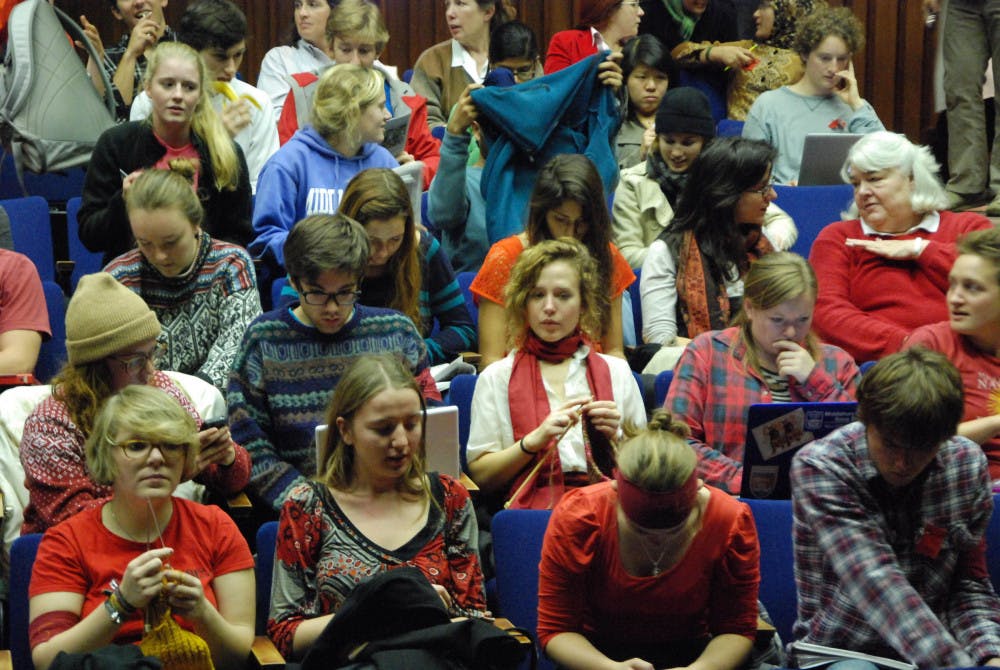For six hours, the members of the Dalai Lama Welcoming Committee (DLWC) sat on the stage of Dana Auditorium facing charges of handbook violations and defending their highly visible call for divestment from arms and fossil fuels. For the first time in recent memory, the inner-workings of the Community Judicial Board were on display before a crowd of hundreds of students, staff and faculty. The open hearing and the DLWC's actions have prompted widespread debate over the nature of activism on campus, the role of a Middlebury education and the prospect of divestment at institutions of higher learning across the US.
Additional reporting and design by IAN STEWART
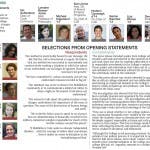
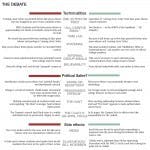
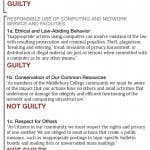
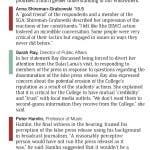

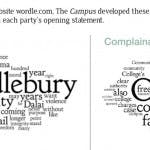
Judicial Process in the Spotlight (by Bronwyn Oatley)
As the first open judicial proceeding in recent memory, Thursday’s hearing served as an opportunity for 272 community members to get a glimpse at one of the most highly confidential procedures on campus.
While the College’s Academic Judicial Board (AJB) and the Community Judicial Board (CJB) are active throughout the academic calendar (hearing an average approximately 5 cases per year respectively), the vast majority of these hearings are conducted behind closed doors. Desiring privacy in cases related to allegations of plagiarism or honor code violations, most opt for a closed proceeding.
When the five students of the DLWC exercised their right to a public hearing however, the College’s judicial process was thrust into the spotlight.
In the days following the hearing, community members have asked: How are board members selected? Are board members permitted to ask ‘leading questions’? Why is the standard of ‘preponderance of guilt’ used? And finally, was the process “fundamentally fair” for all involved?
In interviews with the Campus current board members, as well as those present in the audience, provided their take on the judicial procedure.
“I think it pretty much went as best as it could,” said AJB member, Ian Thomas ’13 who was present in the audience for Thursday’s hearing.
“No perfect process exists, but it’s a lot better than many of the other alternatives that people think about,” he said.
According to Thomas, such care is largely the result of the highly selective judicial board application process. In recent years, 50-70 applicants apply for the twelve student spots available, according to Karen Guttentag, associate dean of judicial affairs and student life.
Upon selection, all board members undergo a two-day training session before school begins, during which members become familiar with the College handbook, discuss the concept of “fundamental fairness,” and are led through a presentation on memory by Matt Kimble, associate professor of psychology.
According to Kate Hamilton ’15.5, another AJB member, “board members do the best that they can” in seeking to ask neutral questions given the challenging nature of the process.
During the judicial training board members are taught the difference between a loaded or leading question, and a neutral question.
“The example that they give us was ‘were you feeling really frustrated at that point?’ rather than ‘how were you feeling at that point?’” she said, emphasizing the variance in the responses that could be given as a result of questioning tactics.
Despite such training, some audience members were critical of the way in which questions were posed by certain board members.
“I thought some of the members of the board were at times unnecessarily aggressive in their questioning, but overall I think they did a really good job,” explained Ryan Urquidi ’13.
“It’s a challenging process for everyone involved,” he said.
Molly Stuart ’15.5, one of the students sanctioned by the College also provided her reaction to the process.
“While no grudge whatsoever is held against any individual board member, we found it difficult to break the boundaries of a bureaucracy that is tilted in favor of the administration,” she wrote in an email.
“It was a struggle to bring to light the main issue — and that is the issue of our endowment funding the destruction of human beings and earth. However, we felt that by the end of the six hour marathon, everyone in the room was receptive to our message.”
Guttentag explained that the College uses the “preponderance of evidence” standard in all hearings, meaning it must be determined that it is “more likely than not” that the student has violated policy.
Although the evidentiary standard is low, at least seven of the eight members of the CJB or six of the seven members of the AJB, must decide that it has been met in order for a finding of guilt.
To a certain degree, Guttentag explained, such a standard is used because of the limitations in the investigative capacity of the College.
“We are an educational institution, we’re not CSI. There is no fingerprinting. There is no DNA. We ask people to be honest with us, but we don’t have the same consequences as a legal process does for people who perjure themselves, so we have to work within the limitations of our community.”
“Essentially, it’s a community problem solving process.”
While no procedural changes are expected as a result of Friday’s open hearing, Guttentag explained that the judicial process will undergo a review this year, and might prompt changes to the academic judicial board procedure.
Faculty Weigh In On Activism (by Michelle Smoler)
Last Thursday’s hearing has bolstered discussion on the ways in which students and faculty can engage in the practical concerns associated with a liberal arts education.
In an op-ed in the Campus, a group of faculty members conveyed their perspective of the Dalai Lama Welcoming Committee’s form of activism as a clear example of the practical outcome of a Middlebury education.
The op-ed reads, “[The DLWC’s] action occurred … because Middlebury is incredibly good at producing critically engaged citizens.” While these faculty members voiced their approval of the DLWC’s actions and lauded this behavior as the pinnacle of the liberal arts, other faculty members expressed a varying range of opinion as to how activism fits in a liberal education.
“Activism [has] two problems with it,” said Charles A. Dana Professor of Political Science Murray Dry. “It deflects us from the deepest possible inquiry into not just what are the right objects of action, but what’s good policy, practical wisdom. We’re missing, I would say, the richest opportunity to engage our rational faculties.”
However, Professor of Geography and Director of the Rohatyn Center Tamar Mayer views activism as a necessary part of the development of engaged citizens.
“I think it’s really important for students to be activists — period,” said Mayer.
Faculty members were more unified however when it came to the role of faculty in educating students in responsible activism, viewing themselves as educators in critical thinking, rather than actors obliged to pass judgment on good and bad activism.
“For me it’s about helping people to educate themselves about how social change happens and it doesn’t always happen through the channels that are deemed responsible and acceptable at any given time,” said Assistant Professor of Sociology and Anthropology Jamie McCallum.
“You’re teaching to adults its not an elementary school, its not a high school,” said Kawashima Professor of Japanese Studies Stephen Snyder. “The people who are in these classes considering these ideas are adults and how they implement them is to a large extent up to them and hopefully you can inculcate the idea that responsibility is the first obligation.”
Groups Continue Divestment Push (by Kelsey Collins)
Calls for action surrounding divesting from the College’s endowment from fossil fuels and war-related industries have been renewed in the wake of last Thursday’s hearing.
Student groups on campus that have been campaigning for divestment —in addition to the Dalai Lama Welcoming Committee (DLWC) — are looking to take advantage of the conversation and momentum that has been set in motion in the aftermath of the public trial.
“I think its going to be a multidimensional approach, and I think that will be most effective in terms of getting the most amount of people engaged and provide a variety of levels of engagement to keep the energy that the trial generated,” said Molly Stuart ’15.5, DLWC member of the group’s approach to divestment going forward.
“We’re trying to keep a creative focus, because we noticed that in order to break through the noise of campus activism, being creative is very essential for keeping the message alive,” Stuart added.
Greta Neubauer ’14.5, a member of Divest for our Future, a group that is part of a national movement on college campuses which seeks to divest endowments from fossil fuels by 2016, also saw the hearing as a conversation-starter on campus.
“We’ve seen that there are different voices and individuals across campus who are interested in these issues, and so we’re hoping that moving forward we can continue to have constructive dialogue surrounding divestment, ” said Neubauer.
Jeannie Bartlett, co-chair of the Socially Responsible Investing club and member of Divest for Our Future added, “As students here, we see this movement as one of the most strategic ways of moving fiscal and intellectual capital in the paradigm shift away from fossil fuels.”
Ben Chute, ’13.5, SRI co-chair, agreed that the hearing brought new life to the conversation surrounding the College’s investments.
“While we wouldn’t endorse [the DLWC’s] tactics, in the end it’s a positive thing. It got the issue on many people’s radar, and they eloquently stated the ideas behind divestment.”
“The administration has a timetable of persistent delay and inaction, but there is an urgency of now. …We don’t have that kind of time, because we know that today there is devastation,” said Jay Saper ’13, another DLWC member. “We are going to continue with this fierce urgency of now. We don’t have the luxury of cooling off.”
Students React to CJB Sanction (by Kathryn DeSutter)
Student audience members at last Thursday’s hearing came out of the experience with strong impressions of the hearing process and the issue of divestment.
Jia Jun Lee ’15, who was still present when the hearing finally concluded just after 9 p.m., felt that the public setting added to the energy around the topic.
“Regardless of what people think of the action, it’s been just a great dialogue and conversation starter on campus,” said Lee.
“This has probably been one of the best educational experiences I’ve had. This what college should be about,” said Lee of the hearing.
Like many students, Dunja Jovicic ’13 valued the hearing as an opportunity to observe the CJB.
“I think the board did as well as they could, as they said, to keep their questions fair and impartial,” said Jovicic.
“I think that the personalities on the board really balanced each other out,” she added. “There were some [members] who were a little bit more reserved in their question-asking and ones who really wanted to get to the bottom of a certain case or certain question.”
Bree Baccaglini ’15 is a member of the Academic Judicial Board, and attended the first two hours of the hearing as an audience member. Baccaglini explained that the CJB’s decision demonstrated their status as an independent body.
“I believed that [the respondents] would get a much stricter punishment … but the fact that these proceedings allowed that kind of result I thought was very affirming for community members to look at the board and say that this is fair and impartial,” said Baccaglini.
Both Baccaglini and Jovicic expressed a desire for the administration to voice its view of the feasibility of divestment.
“Someone on the board [of trustees] could speak on it, perhaps,” said Jovicic.
“I was left questioning, what is the institution’s responsibility to respond to transparency and divestment? And I don’t mean ‘respond’ as in do it, I mean ‘respond’ as in say something more than, ‘you’ve violated the handbook,’” added Baccaglini.

